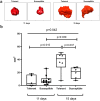Morphological and molecular-biological features of glioblastoma progression in tolerant and susceptible to hypoxia Wistar rats
- PMID: 37542119
- PMCID: PMC10403616
- DOI: 10.1038/s41598-023-39914-9
Morphological and molecular-biological features of glioblastoma progression in tolerant and susceptible to hypoxia Wistar rats
Abstract
Hypoxia is a major pathogenetic factor in many cancers. Individual resistance to suboptimal oxygen availability is subject to broad variation and its possible role in tumorigenesis remains underexplored. This study aimed at specific characterization of glioblastoma progression in male tolerant and susceptible to hypoxia Wistar rats. Hypoxia resistance was assessed by gasping time measurement in an 11,500 m altitude-equivalent hypobaric decompression chamber. Based on the outcome, the animals were assigned to three groups termed 'tolerant to hypoxia' (n = 13), 'normal', and 'susceptible to hypoxia' (n = 24). The 'normal' group was excluded from subsequent experiments. One month later, the animals underwent inoculation with rat glioblastoma 101.8 followed by monitoring of survival, body weight dynamics and neurological symptoms. The animals were sacrificed on post-inoculation days 11 (subgroup 1) and 15 (subgroup 2). Relative vessels number, necrosis areas and Ki-67 index were assessed microscopically; tumor volumes were determined by 3D reconstruction from histological images; serum levels of HIF-1α, IL-1β, and TNFα were determined by ELISA. None of the tolerant to hypoxia animals died of the disease during observation period, cf. 85% survival on day 11 and 55% survival on day 15 in the susceptible group. On day 11, proliferative activity of the tumors in the tolerant animals was higher compared with the susceptible group. On day 15, proliferative activity, necrosis area and volume of the tumors in the tolerant to hypoxia animals were higher compared with the susceptible group. ELISA revealed no dynamics in TNFα levels, elevated levels of IL-1β in the susceptible animals on day 15 in comparison with day 11 and tolerant ones. Moreover, there were elevated levels of HIF-1α in the tolerant animals on day 15 in comparison with day 11. Thus, the proliferative activity of glioblastoma cells and the content of HIF-1α were higher in tolerant to hypoxia rats, but the mortality associated with the tumor process and IL-1β level in them were lower than in susceptible animals. Specific features of glioblastoma 101.8 progression in tolerant and susceptible to hypoxia rats, including survival, tumor growth rates and IL-1β level, can become the basis of new personalized approaches for cancer diseases treatment in accordance to individual hypoxia resistance.
© 2023. Springer Nature Limited.
Conflict of interest statement
The authors declare no competing interests.
Figures






Similar articles
-
Molecular and phenotypic distinctions of macrophages in tolerant and susceptible to hypoxia rats.PeerJ. 2023 Oct 10;11:e16052. doi: 10.7717/peerj.16052. eCollection 2023. PeerJ. 2023. PMID: 37842051 Free PMC article.
-
Upregulation of cytoprotective defense mechanisms and hypoxia-responsive proteins imparts tolerance to acute hypobaric hypoxia.High Alt Med Biol. 2013 Mar;14(1):65-77. doi: 10.1089/ham.2012.1064. High Alt Med Biol. 2013. PMID: 23537263
-
Dependence of the severity of the systemic inflammatory response on resistance to hypoxia in male Wistar rats.J Inflamm Res. 2019 Mar 11;12:73-86. doi: 10.2147/JIR.S194581. eCollection 2019. J Inflamm Res. 2019. PMID: 30881082 Free PMC article.
-
[Effect of Biantie pretreatment on serum level of PHD2/HIF-1α and brain tissue damage in rats during acute hypobaric hypoxia exposure].Zhongguo Zhen Jiu. 2022 Nov 12;42(11):1278-84. doi: 10.13703/j.0255-2930.20211201-k0004. Zhongguo Zhen Jiu. 2022. PMID: 36397226 Chinese.
-
Hypobaric hypoxia-mediated protein expression in plasma of susceptible & tolerant rats.Indian J Med Res. 2014 Dec;140(6):756-65. Indian J Med Res. 2014. PMID: 25758574 Free PMC article.
Cited by
-
Morphological and Molecular Biological Characteristics of Experimental Rat Glioblastoma Tissue Strains Induced by Different Carcinogenic Chemicals.Biomedicines. 2024 Mar 22;12(4):713. doi: 10.3390/biomedicines12040713. Biomedicines. 2024. PMID: 38672069 Free PMC article.
-
Speeding up Glioblastoma Cancer Research: Highlighting the Zebrafish Xenograft Model.Int J Mol Sci. 2024 May 15;25(10):5394. doi: 10.3390/ijms25105394. Int J Mol Sci. 2024. PMID: 38791432 Free PMC article. Review.
-
Murine models of colorectal cancer: the azoxymethane (AOM)/dextran sulfate sodium (DSS) model of colitis-associated cancer.PeerJ. 2023 Oct 31;11:e16159. doi: 10.7717/peerj.16159. eCollection 2023. PeerJ. 2023. PMID: 37927787 Free PMC article. Review.
-
Characteristics of the Antitumor Effect of Doxorubicin and Pegylated Hyaluronidase on Models of Rat Brain Tumors.Bull Exp Biol Med. 2024 May;177(1):147-154. doi: 10.1007/s10517-024-06147-3. Epub 2024 Jul 4. Bull Exp Biol Med. 2024. PMID: 38963598
References
Publication types
MeSH terms
Substances
LinkOut - more resources
Full Text Sources

